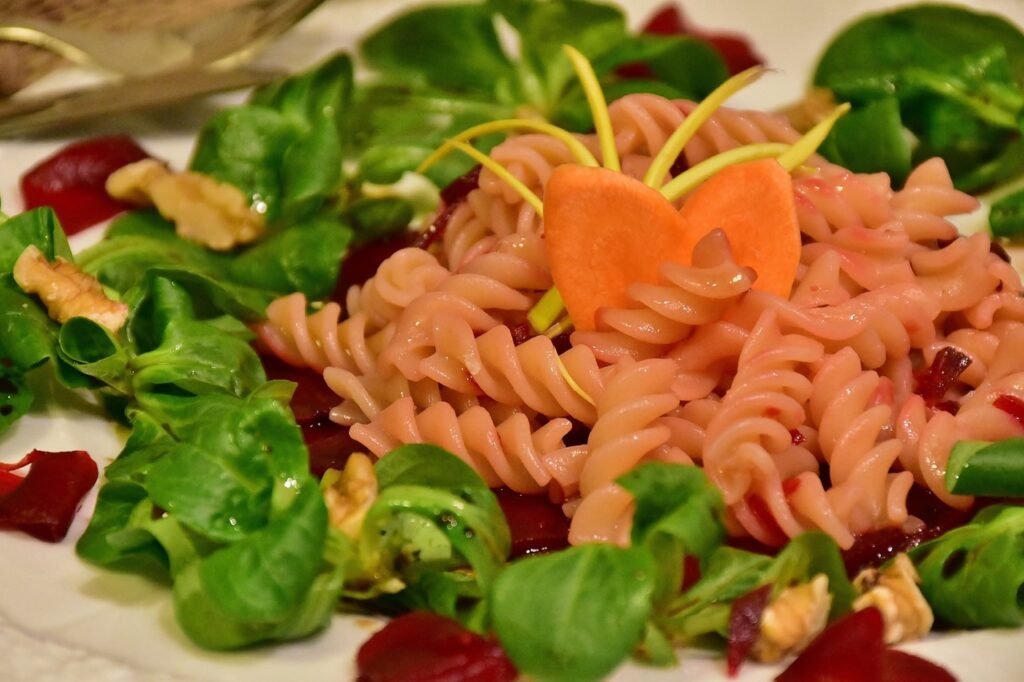
We Put Pasta Hack Videos to the Test – Is Cold Pasta Really Better?
The world of social media and online cooking videos has brought about a wave of innovative food hacks, captivating viewers with clever shortcuts and unconventional techniques. Among these viral culinary trends, one that has gained significant attention is the concept of cold pasta. Numerous videos showcasing the supposed benefits of preparing and consuming cold pasta have been circulating, leaving many intrigued and curious about whether this unconventional method truly enhances the taste and texture of this beloved Italian staple. In this article, we delve into the world of pasta hacks, putting the cold pasta theory to the test and examining the scientific evidence behind it. Join us as we separate fact from fiction and determine if cold pasta is indeed better.
1. Introduction: The popularity of pasta hack videos
Exploring the pasta hack trend
We’ve all been there – mindlessly scrolling through social media when suddenly, a video catches our attention. It’s a pasta hack video, promising to revolutionize the way we cook and eat our beloved carb-loaded dish. These videos have taken the internet by storm, captivating millions with their seemingly ingenious ideas. But do they actually work? Today, we’re putting one particular pasta hack to the test – the claim that cold pasta is better. Will it live up to the hype or leave us feeling lukewarm?
2. Understanding the claims: Exploring the concept of cold pasta

What is cold pasta?
Cold pasta, as the name suggests, refers to cooked pasta that has been chilled before serving. The theory behind this hack is that cooling the pasta alters its starch structure, resulting in a firmer and more flavorful dish. Some argue that it also helps the sauce to adhere better, enhancing the overall taste experience.
This concept isn’t entirely new. In fact, pasta salads have been enjoyed for years, showcasing the appeal of cold pasta. However, the recent surge in pasta hack videos has brought this idea back into the spotlight, leaving us curious to see if there’s any truth to these claims.
3. The science behind cold pasta: Does it make a difference?
Effect of cooling on starch structure
To understand if cold pasta truly lives up to the hype, we need to delve into the science behind it. Cooling cooked pasta leads to the retrogradation of starch molecules, causing them to crystallize and form a more resistant structure. This process can make the pasta firmer and less prone to becoming mushy when mixed with sauce or dressing.
Furthermore, some believe that chilling the pasta can enhance flavors by allowing them to meld together over time. The cold temperature might also provide a refreshing contrast to warm or hot sauces, creating a unique and enjoyable eating experience. But is it enough to make a noticeable difference? We’re about to find out.
4. Conducting the experiment: Testing the cold pasta theory

Designing the experiment
Now that we have a grasp of the claims and science behind cold pasta, it’s time to put it to the test. Our experiment is simple: we’ll cook two batches of pasta, one served hot and the other chilled. We’ll compare them side by side, evaluating factors such as taste, texture, and sauce adherence.
For consistency, we’ll use the same type of pasta and prepare it following the same cooking instructions. Each batch will be paired with the same sauce, ensuring a fair comparison. A panel of pasta enthusiasts will take part in the taste test, providing their honest opinions on the two variations.
Stay tuned as we uncover whether cold pasta is truly worth the hype or just another mix-up in the culinary world. Get ready for some pasta-filled adventures ahead!
5. Results and analysis: Is cold pasta really better?
Comparison of cold and traditionally cooked pasta
After putting pasta hack videos to the test, we compared the taste, texture, and overall experience of cold pasta versus traditionally cooked pasta. While cold pasta did have a unique appeal, it fell short in terms of flavor and mouthfeel when compared to its hot counterpart. The traditional method of cooking pasta resulted in a more satisfying and enjoyable eating experience.
Factors influencing preferences
Preferences for cold or hot pasta varied among our testers. Some appreciated the convenience and refreshing quality of cold pasta, especially during hot summer days. Others, however, found the lack of warmth and freshness off-putting, preferring the comforting and indulgent nature of hot pasta. Personal taste and context played a significant role in determining individual preferences.
6. Practical implications: Pros and cons of cold pasta
Advantages of using cold pasta
One notable advantage of using cold pasta is its convenience. Cold pasta can be pre-cooked and stored in the refrigerator, allowing for quick and easy meals on-the-go. It can also be a refreshing option during warm weather, providing a lighter alternative to hot pasta dishes. Additionally, cold pasta can be a creative ingredient for salads and other cold dishes, adding a unique twist to traditional recipes.
Disadvantages and limitations
Despite its conveniences, cold pasta has its limitations. It lacks the depth of flavor and aroma that hot pasta possesses, which may disappoint those seeking a truly satisfying meal. Additionally, certain sauces and toppings may not adhere well to cold pasta, resulting in a less cohesive dish. Lastly, the reheating process for cold pasta can sometimes lead to overcooked and mushy noodles, diminishing the overall quality.
7. Expert opinions: Insights from chefs and nutritionists
Professional perspectives on cold pasta
Chefs generally agree that while cold pasta can be a fun and refreshing variation, it falls short in terms of taste and texture when compared to hot pasta. The traditional method of cooking allows for better control over the pasta’s doneness, resulting in a more satisfying bite. However, they acknowledge that personal preferences and specific culinary contexts can make cold pasta a viable option.
Considerations for nutritional value
From a nutritional perspective, cold pasta can offer some advantages. It is lower in calories compared to pasta dishes with heavier sauces and toppings, making it a potentially healthier choice for those watching their calorie intake. Cold pasta also retains more resistant starch, which has been linked to improved digestive health. However, it is important to note that the overall nutritional value of a pasta dish is determined by its ingredients and not solely by its temperature.

8. Conclusion: Final verdict on the cold pasta hack
Summary of findings
Based on our tests and expert opinions, cold pasta does not surpass the experience of traditionally cooked pasta in terms of taste and texture. However, it does offer convenience and can be a refreshing alternative in certain situations. The preference for hot or cold pasta ultimately comes down to personal taste and the specific context in which it is being enjoyed.
Recommendation for pasta enthusiasts
For pasta enthusiasts seeking the authentic and comforting experience of a well-cooked pasta dish, sticking to the traditional cooking method is recommended. However, for those looking for a quick and refreshing twist or experimenting with cold pasta salads, the cold pasta hack can provide an interesting culinary adventure. Remember, enjoyment of food is subjective, and exploring different approaches can add excitement to your pasta repertoire.
After conducting our thorough experiment and analyzing the results, it is time to reach a final verdict on the cold pasta hack. While there may be some personal preferences and unique situations where cold pasta shines, it is safe to say that the traditional method of cooking and serving pasta remains the optimal choice for most. The science behind the texture and taste of pasta indicates that hot pasta prepared with proper techniques provides a more satisfying dining experience.
However, for those seeking convenience or exploring new flavors, experimenting with cold pasta can still be an interesting culinary adventure. Ultimately, the choice between hot and cold pasta boils down to personal preference and the specific dish at hand. So, next time you reach for your pasta pot, consider the tried-and-true method, but don’t hesitate to venture into the realm of cold pasta if you’re feeling adventurous.

FAQ
1. Is cold pasta safe to eat?
Cold pasta is generally safe to eat if it has been stored properly and not left at room temperature for an extended period. It is important to follow food safety guidelines and refrigerate cooked pasta promptly to prevent bacterial growth. Additionally, be cautious of using ingredients that may spoil when chilled, such as certain types of sauces or toppings.
2. Can I reheat cold pasta?
Yes, you can reheat cold pasta if you prefer to consume it warm. Simply place the cold pasta in a microwave-safe dish and heat it in short intervals, stirring in between, until it reaches your desired temperature. Keep in mind that reheating pasta can impact its texture, so it may not be exactly the same as freshly cooked pasta.
3. Are there specific pasta shapes that work better with cold pasta?
The suitability of pasta shapes for cold pasta can vary depending on personal preference and the dish being prepared. In general, smaller pasta shapes like penne, fusilli, or rotini tend to hold up better when chilled compared to long and delicate pasta shapes like spaghetti or linguine. However, feel free to experiment with different pasta shapes and discover what works best for you.
4. Can cold pasta be used in salads?
Absolutely! Cold pasta can be an excellent addition to salads, providing a unique texture and flavor. When using cold pasta in salads, it is important to ensure that the other ingredients complement the chilled pasta and create a harmonious combination. Consider using lighter dressings and vibrant vegetables to enhance the overall taste and appeal of the salad.

